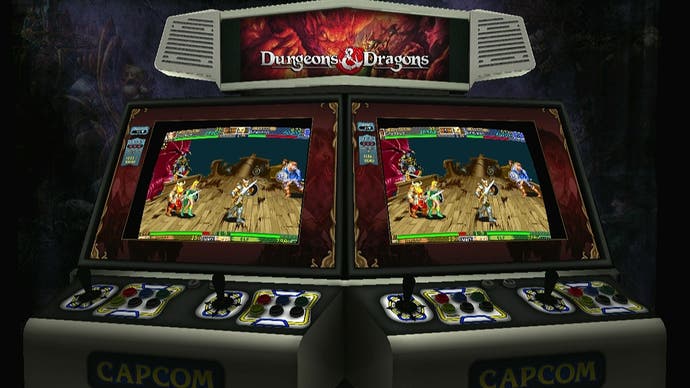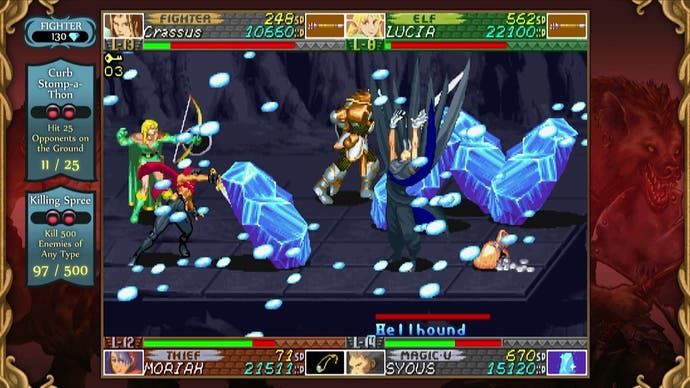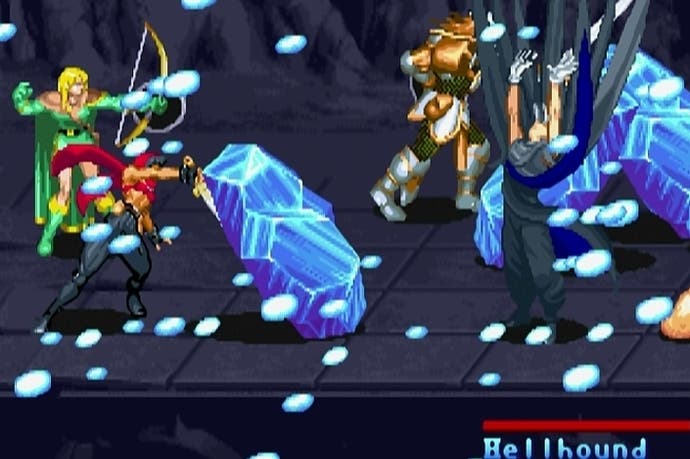Dungeons & Dragons: Chronicles of Mystara review
How I met your mother of dragons.
Back when arcades were filled with bat-top sticks, adjustable racing seats and plastic machine-guns that you could pivot in place like an oversized joystick, making that one credit last as long as humanly possible was the ultimate goal. Conversely, arcade game manufacturers wanted your game to expire in a timely manner. Not so quick that you immediately lost interest and set off in search of something less punishing, but not so long that you could see the credits roll for the price of a sandwich. It was a balancing act, one that required subtlety, and nowhere were the scales more apparent than with the classic scrolling beat-'em-up.
After the success of Final Fight and Knights of the Round in the late 80s and early 90s, Capcom dispensed a pair of Dungeons & Dragons beat-'em-ups that went beyond the usual health item and weapon drops. This began with Tower of Doom in 1993, a game that gave players an inventory crammed full of daggers, arrows and magic rings, and when Shadow Over Mystara surfaced three years later, the loot system expanded to include equibbable armour and magic talismans. Now that Iron Galaxy has re-mastered this pair of sprite slayers, is it worth revisiting these dungeons with the added advantage of infinite credits?
In the case of Mystara, the answer is a firm yes, because while Tower of Doom is a fantasy-themed button-basher that flatters to deceive, its sequel is the real deal.

You start each game by selecting one of six D&D archetypes. The Fighter is your typical close-combat powerhouse with health to spare; the Dwarf has less range but makes up for it by double-dipping on treasure chests; the Thief wins in terms of speed and can steal items; the Cleric can use healing magic as well as turning the undead; the Magic User is a formidable glass-cannon; and the Elf is your jack-of-all.
Both games can be tackled as a solo quest if you don't mind being shorthanded in later stages, but if you embrace join a band of up to four fellow adventurers then the experience is heightened considerably. Mystara also diminishes the possibility of select-screen squabbling by letting two players pick the same character, which means you can go cast crazy with a Cleric, an Elf and two Magic Users or go for a more considered slash-and-loot approach with double Dwarves and a pair of Thieves. Completion time is unlikely to exceed two hours, but a large part of Mystara's charm lies in its hidden areas and branching pathways.
At first, you'll pick one intersection over another purely on whim, but as the playthroughs start to mount and you develop a deeper understanding of where the choicest special items are and how they unlock secret weapons and areas, you'll start following specific paths that can lead to everything from the Dragon Slayer sword to the satisfyingly over-the-top Final Strike spell. Iron Galaxy has tapped this treasure-hunting mentality further by challenging players to discover every item across both games - the checklist is completely optional, but finding the elusive Eye of Beholder or Ice Shield can be a satisfying challenge in itself.

As rewarding as the exploration is, the combat system is comparatively conservative. This seems strange considering the shotokan sensibilities of the developers, but in truth Mystara is more about understanding each character within a cohesive team rather than building fancy combos. Guardian Heroes more than defends its title in this respect, but that doesn't mean Mystara is devoid of tricks. Most characters have lunging, desperation and dragon punch-style attacks, and you can even perform a counter after blocking a strike with your shield. It's all about picking your moments without over-committing and making use of the evasive slide.
Another of the game's strengths is the fusion of western fantasy and eastern anime it uses to bring the D&D world to life. It's not as dark and foreboding as you might expect, and there's an unmistakable sense of playfulness behind the hyena-like gnolls and cuddly owlbears that you fight during the early stages. There's also a sense that these games were put together on a fairly tight deadline - even though the ogre brothers, shadow elves and titular dragons offer a steady challenge, some of the animations are a tad simplistic.
This isn't really a criticism, though - it's more an observation of how much game the original development team managed to cram onto a single arcade board, and with Iron Galaxy in charge of the rejuvenation, this compilation quickly asserts itself as the definitive Mystara experience. The filter and scan-line options are back in force and can make the game look blissfully nostalgic or surprisingly contemporary, and there are a variety of tier-based challenges that range from killing 1000 enemies to using the Polymorph spell to change three enemies into harmless animals.

Anyone who's played 3rd Strike Online or Darkstalkers Resurrection should have some idea of what to expect, although Chronicles isn't without its flaws. One disappointment comes from the lack of new content. A boss rush mode or a new level or two would have made this a more appealing package for those who already know the arcade games inside out, and while the seven unlockable House Rules are a welcome addition - letting you turn the game into a frantic time attack or making it so that equippable items never break - they're statistical tweaks as opposed to additional substance.
Another minor shortcoming is in the otherwise-comprehensive online modes. You can join a Quick Match, search for a Custom Match and choose which of the four difficulty settings to play in Create Match, but you can't mix and match local and online co-op. This seems like a bit of an oversight when you consider that couch-based adventurers will be looking for that elusive fourth party member and vice versa. It's a slight dent in an otherwise polished set of online features that include the flexible GGPO netcode.
As a retro revival, Chronicles of Mystara does a commendable job of raising a fondly remembered arcade game from its grave. Tower of Doom offers the more traditional beat-'em-up experience while Shadows Over Mystara fuses the hack-and-slash fundamentals with a number of role-playing mechanics. The result was and remains a refreshing hybrid that functions as a solo experience and positively shines when questing together. It's a ball-breaker in terms of difficulty - something that's unavoidably muffled by the limitless credits you can now chew through without a second thought - but if this means more gamers can now experience these classic games without jumping through nefarious or costly hoops, it's a small price to pay.

